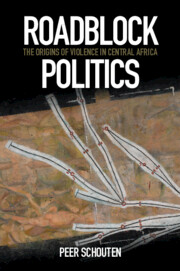Book contents
- Roadblock Politics
- Roadblock Politics
- Copyright page
- Epigraph
- Contents
- Figures
- Maps
- Tables
- Preface and Acknowledgements
- 1 Introduction: Sovereignty on a Shoestring
- Part I A Prehistory of the Roadblock
- 2 Hongo Polities (1830–1890)
- 3 Infrastructural Empire and Anti-colonial Resistance (1890–1960)
- 4 Ruination and the Revenge of Distance (1960–2000)
- Part II Roadblock Politics
- Conclusions
- Bibliography
- Index
3 - Infrastructural Empire and Anti-colonial Resistance (1890–1960)
from Part I - A Prehistory of the Roadblock
- Roadblock Politics
- Roadblock Politics
- Copyright page
- Epigraph
- Contents
- Figures
- Maps
- Tables
- Preface and Acknowledgements
- 1 Introduction: Sovereignty on a Shoestring
- Part I A Prehistory of the Roadblock
- 2 Hongo Polities (1830–1890)
- 3 Infrastructural Empire and Anti-colonial Resistance (1890–1960)
- 4 Ruination and the Revenge of Distance (1960–2000)
- Part II Roadblock Politics
- Conclusions
- Bibliography
- Index
Summary
Early colonialism took shape in efforts to control trade routes, replacing hongo polities with its own stations. But at the end of the nineteenth century, new forms of logistical power emerged that would allow for a radical intensification of colonial control, a connection so tight I propose we need to approach it as ‘infrastructural empire’. Whereas much ink was spilled in colonial metropoles hailing the unlimited possibilities afforded by railways and motorable roads, the reach of colonial control in the Congo Basin actually proved quite limited. Across most of Central Africa, it was restricted to the slender lines of individual transport routes, and new forms of resistance beset the advancing logistical machinery. Whereas before colonization Africans had moved to the trade routes to impose taxation, now that these pathways became vehicles of colonial violence, they systematically moved away from them to avoid it. From the cover of the bush and at crucial nodes in the transport system, Africans started to sabotage the logistics on which the new colonial order relied. Such forms of resistance precipitated a colonial obsession with mastering unruly and impenetrable landscapes beyond the logistical reach of the colonial state.
Keywords
- Type
- Chapter
- Information
- Roadblock PoliticsThe Origins of Violence in Central Africa, pp. 54 - 86Publisher: Cambridge University PressPrint publication year: 2022

